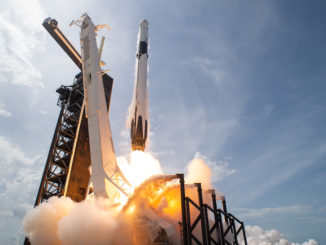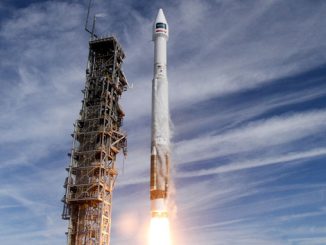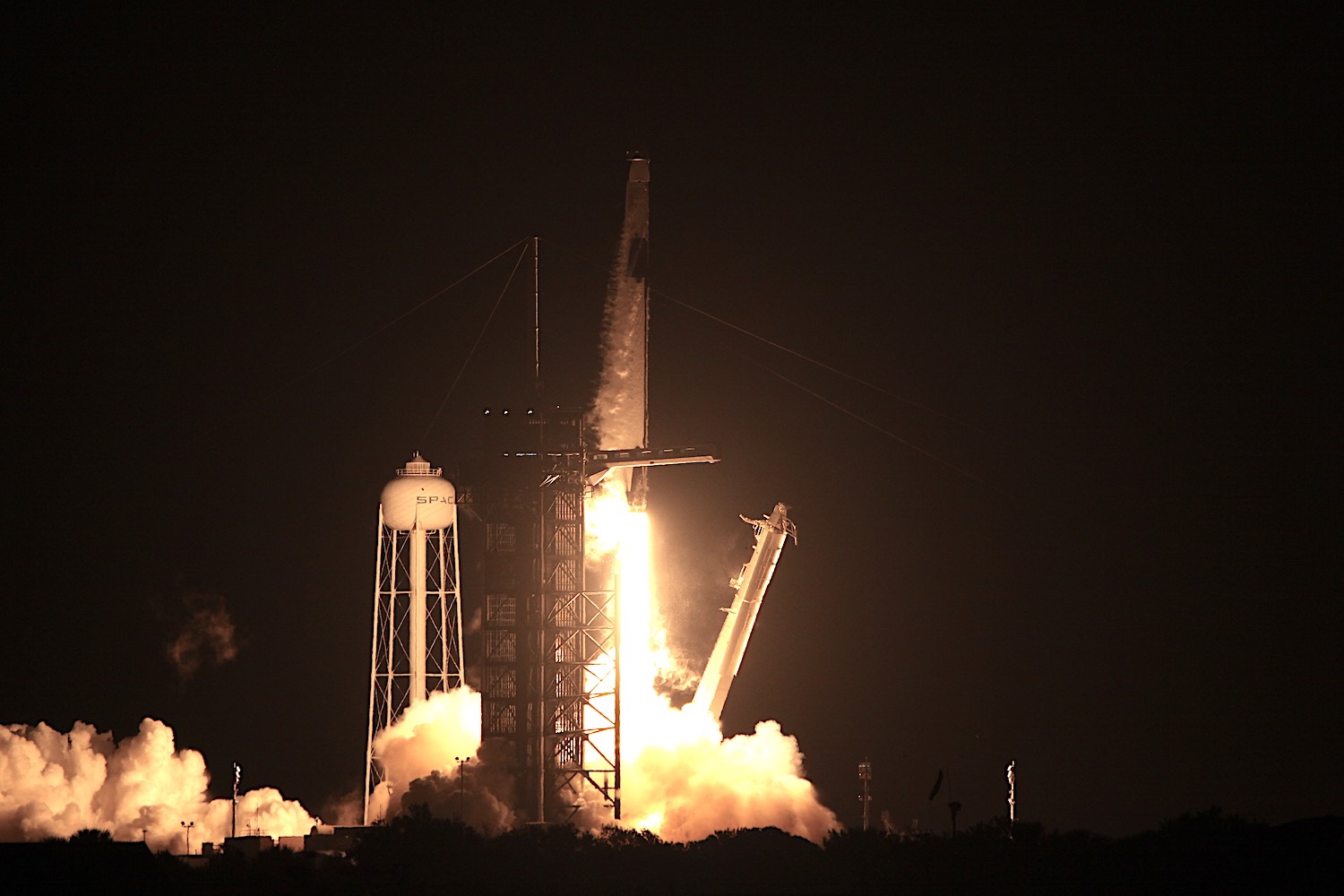
A Crew Dragon capsule ferried four astronauts into space Sunday night after a rumbling departure from the Kennedy Space Center in Florida, setting off on a 27-hour pursuit of the International Space Station on SpaceX’s first operational crew rotation flight to the orbiting outpost.
The commercial crew capsule, named “Resilience” by its four-person crew, rocketed off pad 39A at the Florida spaceport at 7:27:17 p.m. EST Sunday (0027:17 GMT Monday). A 215-foot-tall (65-meter) Falcon 9 rocket gave the Crew Dragon spacecraft a fiery ride into orbit.
NASA commander Mike Hopkins was joined inside the crew capsule by pilot Victor Glover, mission specialist Shannon Walker, and Japanese astronaut Soichi Noguchi. The four-person team is heading for a nearly six-month expedition on the space station, where the Dragon spaceship is due to dock at 11 p.m. EST Monday (0400 GMT Tuesday).
The Falcon 9 launcher streaked into a clear evening sky, taking aim on the International Space Station as it flew northeast from Florida’s Space Coast powered by nine Merlin 1D engines generating 1.7 million pounds of ground-shaking thrust.
Two-and-a-half minutes into the mission, the Falcon 9’s 15-story-tall first stage shut down and separated to begin falling toward a controlled propulsive landing on a SpaceX drone ship parked in the Atlantic Ocean.
The rocket’s upper stage ignited its single Merlin-Vacuum engine and accelerated into orbit with Hopkins and his crewmates. SpaceX mission control regularly radioed status reports to the Dragon crew as the rocket headed up U.S. East Coast, then crossed the Atlantic Ocean on a course toward the British Isles.
The Falcon 9 shut down its upper stage engine around nine minutes after liftoff, and the rocket deployed the Crew Dragon Resilience spacecraft about three minutes later. The rocket’s first stage booster, meanwhile, nailed an on-target landing on SpaceX’s offshore recovery platform for reuse on SpaceX’s next crew mission in 2021.
“To the entire Falcon 9 team, well done, that was one heck of a ride,” Hopkins said shortly after launch. “There was a lot of smiles (up here) … Making history is definitely hard and you guys all made it look easy. Again, congratulations to everyone. Resilience is in orbit.”
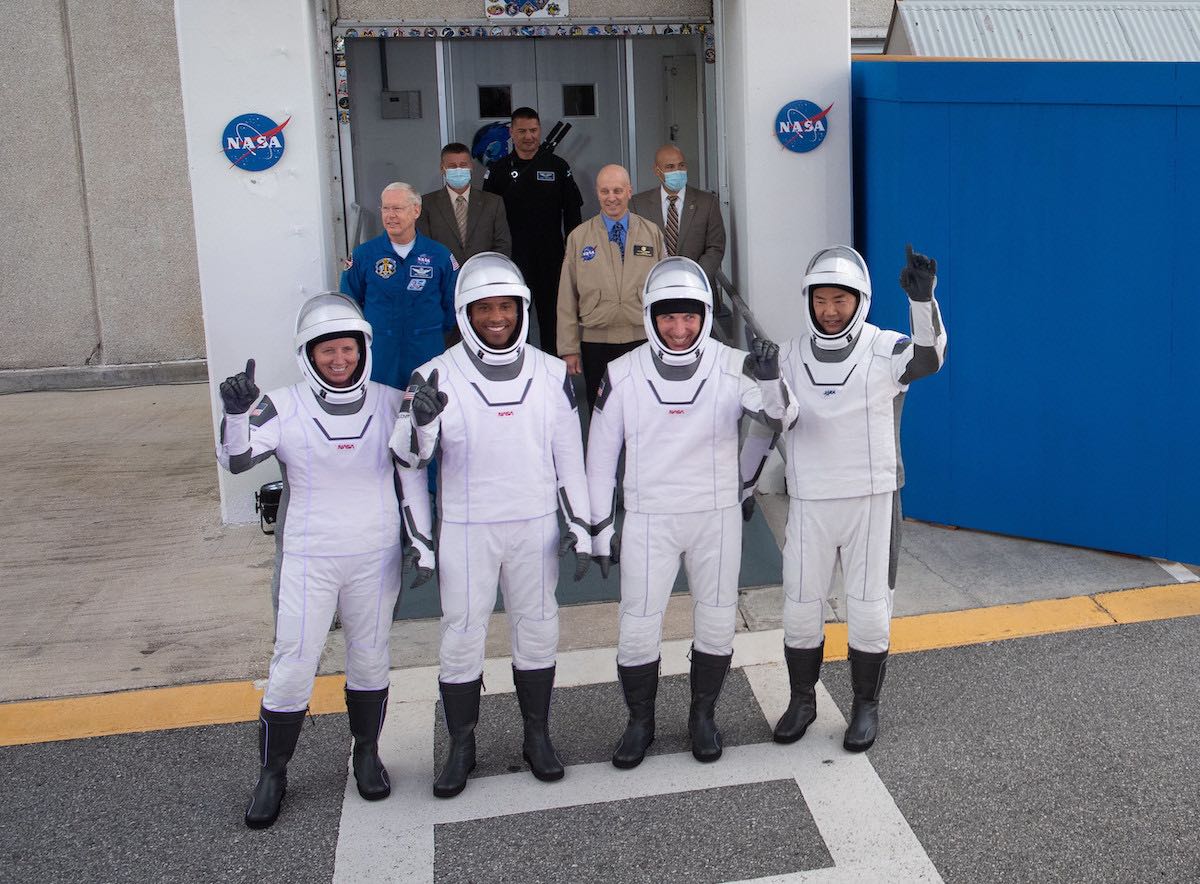
The successful blastoff marked the start of the first human spaceflight mission to Earth orbit operated as a commercial service.
SpaceX, working under contract to NASA, built the Falcon 9 rocket and Crew Dragon spacecraft, own both vehicles, and control the mission from its corporate headquarters in Hawthorne, California, near Los Angeles.
The first “operational” Crew Dragon mission, known as Crew-1, will pave the way for more commercial flights to orbit carrying professional astronauts and paying passengers.
The Crew-1 mission is the first of at least six space station crew rotation flights NASA has contracted to SpaceX, following a successful demonstration mission to the space station earlier this year.
NASA astronauts Doug Hurley and Bob Behnken launched May 30 on the Crew Dragon’s final developmental test flight, ending a nearly nine-year gap in independent human spaceflight capability to low Earth orbit after the retirement of NASA’s space shuttle fleet.
Hurley and Behnken spent two months on the space station before returning to Earth for a parachute-assisted splashdown on their Crew Dragon Endeavour spacecraft in the Gulf of Mexico on Aug. 2.
After reviewing data from the test flight, SpaceX engineers reinforced part of the Crew Dragon’s heat shield and made several other adjustments before managers cleared the Crew-1 mission for launch.
NASA officials formally certified the Crew Dragon spacecraft and Falcon 9 rocket for operational flights during a two-day Flight Readiness Review last week.
“The big milestone here is we are now moving from development and test and into operational flights,” said NASA Administrator Jim Bridenstine.
NASA has spent $6 billion over the last decade helping companies develop new commercial human-rated spacecraft. In 2014, the space agency selected SpaceX and Boeing as partners to complete development of the Crew Dragon and Starliner crew capsules.
SpaceX has signed agreements with NASA valued at more than $3.1 billion to cover design, testing, and six operational flights of the Crew Dragon spacecraft.
The launch Sunday night was licensed by the Federal Aviation Administration — the first time that agency has licensed a crew launch into Earth orbit. The FAA regularly licenses commercial satellite launches by U.S. companies.
“I believe 20 years from now, we’re going to look back at this time as a major turning point in our exploration and utilization of space,” said Phil McAlister, director of commercial spaceflight development at NASA Headquarters. “It’s not an exaggeration to state that with this milestone, NASA and SpaceX have changed the historical arc of human space transportation.”
“Not only can NASA transport our astronauts to and from the International Space Station with U.S. systems, but now, for the first time in history, there is a commercial capability from a private sector entity to safely and reliably transport people to space,” McAlister said in a pre-launch conference call with reporters.
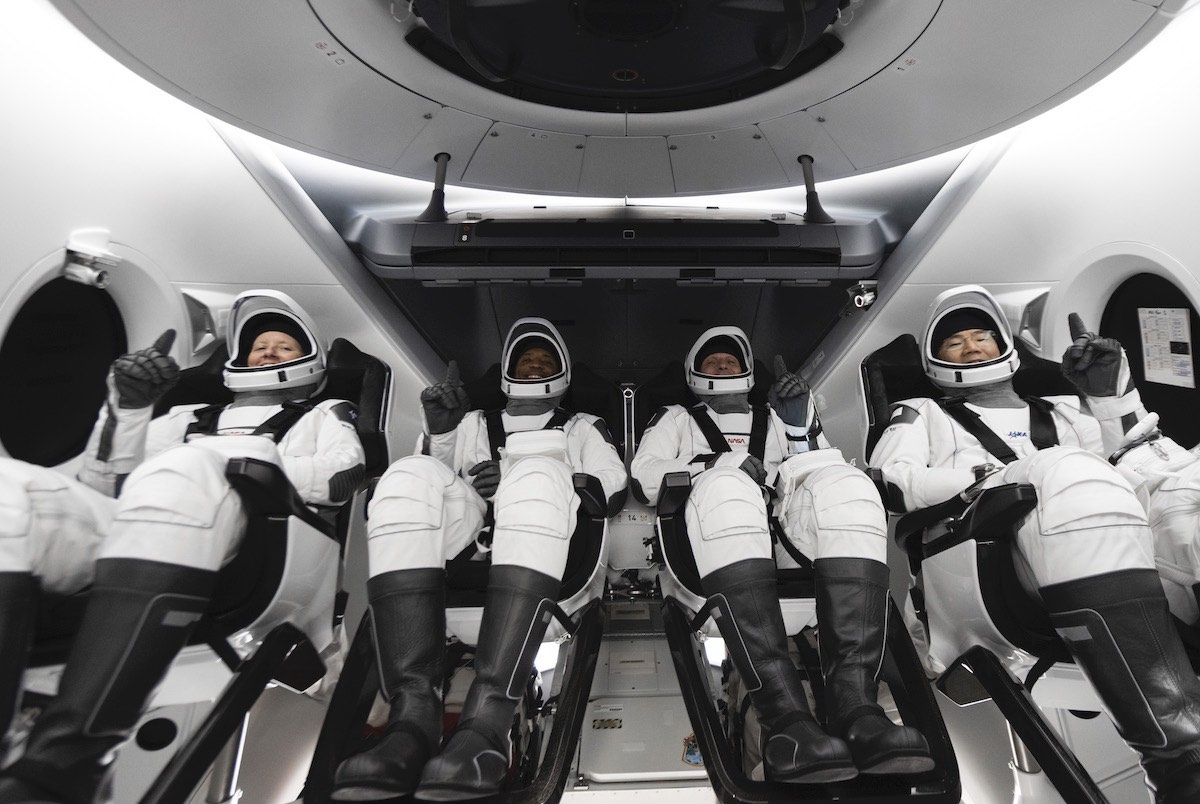
The Commercial Crew Program has its roots in the Obama administration, which canceled NASA’s Constellation moon program in 2010 after the George W. Bush administration’s lunar exploration initiative suffered delays and cost overruns.
An independent commission found in 2009 that it would cost more than $34 billion to complete the first phase of the Constellation program, which would have fielded the Ares 1 rocket and an Orion crew capsule capable of flights to the International Space Station.
McAlister said the Commercial Crew Program saved taxpayers between $20 billion and $30 billion, and will result in two independent crew transportation systems for low Earth orbit missions, once the Crew Dragon and Starliner spaceships are both cleared for operational flights.
Boeing’s Starliner has not yet flown with astronauts, and the aerospace contractor plans a second unpiloted test flight in early 2021 after software problems cut short the Starliner’s first orbital demonstration mission last year.
The Crew Dragon and Starliner could fly private astronauts on standalone missions without going to the International Space Station. Eventually, the commercial capsules could transport researchers, space tourists, and professional astronauts to privately-owned outposts in orbit.
Although officials hailed the Crew-1 mission as a milestone toward making human spaceflight more affordable and routine, NASA and SpaceX officials said they would stay vigilant in assessing technical risks on future commercial crew launches.
“Make no mistake, every flight is a test flight when it comes to space travel, but it’s also true that we need to routinely be able to go the International Space Station,” Bridenstine said.
Hopkins, commander of the Crew Dragon Resilience spacecraft, said one of the goals of his flight is to “put the vehicle through its operational paces.”
The Crew-1 mission is the first time four astronauts have flown on a Crew Dragon spacecraft — and the first time a four-person crew have been inside any capsule in orbit. Past space missions flying on crew capsules have carried no more than three astronauts, while NASA’s space shuttle accommodated as many as eight astronauts.
Hopkins and his crewmates will fly nearly three times longer than the Crew Dragon test flight earlier this year, pushing the capsule close to its 210-day maximum mission duration.
“Bob and Doug’s mission was the developmental test mission,” Glover said in a pre-flight press conference, referring to Crew Dragon’s Demo-2 mission. “As soon as we hit Day 64, that’s going to be the first time that a Crew Dragon at the space station his hit that milestone, and every day after that will be new territory.”
“In general, I think it’s more of an operational checkout than development testing,” Hopkins said.
The start of commercial Crew Dragon service ends NASA’s sole reliance on Russian Soyuz spacecraft to ferry astronauts to and from the space station.
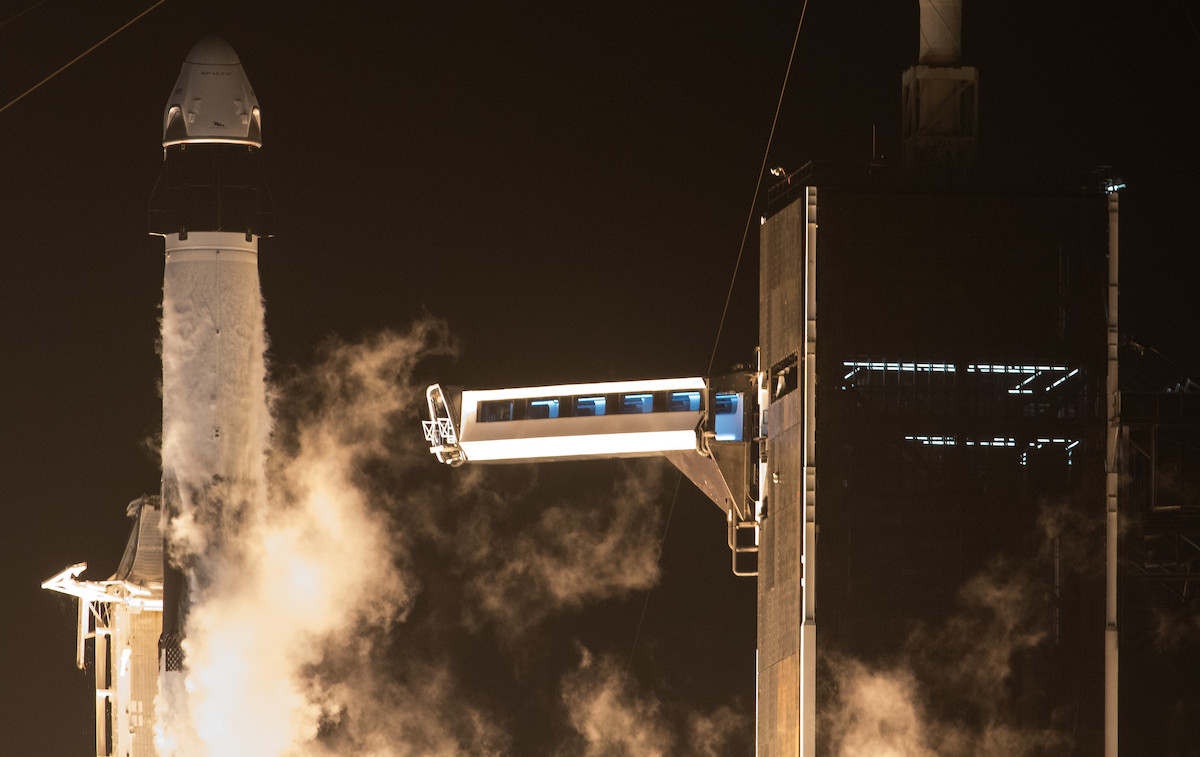
Hopkins, 51, is a native of Missouri and a colonel in the U.S. Air Force. He served as a flight test engineer before his selection as a NASA astronaut in 2009, then completed a 166-day expedition on the space station in 2013 and 2014. NASA named him to command the first operational Crew Dragon mission in 2018.
Glover is the mission’s rookie, and he is set to become the first Black astronaut to live and work on the space station for a long-duration expedition. The 44-year-old U.S. Navy test pilot was born and raised in Southern California, graduated with a bachelor’s degree in engineering from Cal Poly, then flew F/A-18 fighter jets before joining NASA’s astronaut corps in 2013.
Shannon Walker was born in Houston and earned a bachelor’s degree, master’s degree, and a PhD in space physics from Rice University. Walker, 55, was a flight controller and integration engineer on the space shuttle and space station before NASA selected her as an astronaut in 2004. She logged 163 days in orbit on the space station in 2010.
Noguchi, 55, is the most experienced astronaut on the Dragon crew. With Sunday night’s launch, Noguchi became the third person to blast off from Earth and fly into orbit on three different types of spacecraft, joining a small club with legendary NASA astronauts Wally Schirra and John Young.
He previously flew on a space shuttle mission and launched on a Russian Soyuz rocket to the space station. The Crew-1 mission is Noguchi’s third spaceflight.
After docking Monday night, the four Dragon astronauts will join NASA astronaut Kate Rubins and Russian cosmonauts Sergey Ryzhikov and flight engineer Sergey Kud-Sverchkov on the International Space Station, raising the size of the lab’s long-term crew to seven people for the first time.
Rubins, Ryzhikov, and Kud-Sverchkov launched Oct. 14 on a Soyuz spacecraft.
The space station has typically operated with six people on-board. The addition of a seventh crew member will increase the pace of scientific experiments on the orbiting lab, NASA officials said.
The seven-person crew will also perform a series of spacewalks, oversee arrivals and departures of cargo freighters, and perform maintenance tasks on the space station.
The next Crew Dragon mission is tentatively scheduled to launch March 30 with an all-veteran crew consisting of NASA commander Shane Kimbrough, pilot Megan McArthur, Japanese astronaut Akihiko Hoshide, and European Space Agency astronaut Thomas Pesquet. They will ride the same Crew Dragon Endeavour capsule that Hurley and Behnken flew earlier this year.
A fresh three-man team of Russian cosmonauts will launch around April 10 to replace Rubins, Ryzhikov, and Kud-Sverchkov, who are slated to land in their Soyuz capsule in mid-April. Then Hopkins and his crewmates will leave the complex and head splashdown in the Atlantic Ocean or Gulf of Mexico some time around May 1.
But first, the Crew Dragon Resilience spacecraft has to link up with the International Space Station Monday night. The capsule accomplished its first major rocket firing around 45 minutes after liftoff Sunday, setting the stage for additional maneuvers Monday to approach the station.
Ground controllers at SpaceX’s operations center in Hawthorne tracked several technical problems on the spacecraft soon after launch Sunday night.
One of the issues involved thermal control loops on the crew capsule. Automated sensors detected a pressure spike in the spacecraft’s cooling system, but engineers on the ground restored the coolant loops to full capability.
Then mission control studied “high resistance” readings that temporarily disabled three of four propellant line heaters associated with a group of Draco thrusters on the spacecraft. Flight rules require at least two of four propellant line heaters be working, briefly raising concerns that the heater glitch might impact the capsule’s journey to the space station.
Ground teams determined the issue was triggered by a software limit that was set too conservatively, causing the three heaters to be taken offline. After relaxing the resistance limit, all four heaters in the Draco thruster quad were reactivated, restoring the system to full redundancy.
“That is excellent news,” Hopkins said. “Good to hear — back to full fault tolerance for the prop manifold heaters,” Hopkins said.


